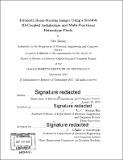Terahertz beam-steering imager using a scalable 2D-coupled architecture and multi- functional heterodyne pixels
Author(s)
Zhang, Guo (Electrical and computer science engineer) Massachusetts Institute of Technology
DownloadFull printable version (5.211Mb)
Other Contributors
Massachusetts Institute of Technology. Department of Electrical Engineering and Computer Science.
Advisor
Ruonan Han.
Terms of use
Metadata
Show full item recordAbstract
The topic covered by this thesis is the project of designing a terahertz imager chip on nowadays commercialized mature silicon platform. In the project, we developed the design method of a multi-functional heterodyne pixel and a scalable array architecture. The pixel is a compact electromagnetic structure simultaneously performs voltage-controlled 140 GHz local oscillation, 280-GHz-signal receiving, sub-harmonic mixing, and intermediate frequency (IF) signal extraction. Each pixel consumes 10 mW power and achieves a sensitivity of 2.9 pW in simulation. The local oscillator (LO) of the pixel is phase coupled with its neighbors; the whole oscillator array is then stabilized by an on-chip THz phase-locked loop. This architecture gives excellent array scalability. First, the LO power is evenly distributed and does not degrade in a larger array scale as a normal centralized array does. Second, the phase noise of the coupled LO network improves linearly with the array size. The simulated phase noise at 1-MHz frequency offset is -90 dBc/Hz for an 8 x 8 array and -101 dBc/Hz for a 32 x 32 array. This chip is capable of digital beam steering, too. The first version of the chip prototype with a 10 x 10 array is fabricated using a 130-nm SiGe BiCMOS process and tested.
Description
Thesis: S.M., Massachusetts Institute of Technology, Department of Electrical Engineering and Computer Science, 2017. Cataloged from PDF version of thesis. Includes bibliographical references (pages 47-49).
Date issued
2017Department
Massachusetts Institute of Technology. Department of Electrical Engineering and Computer SciencePublisher
Massachusetts Institute of Technology
Keywords
Electrical Engineering and Computer Science.